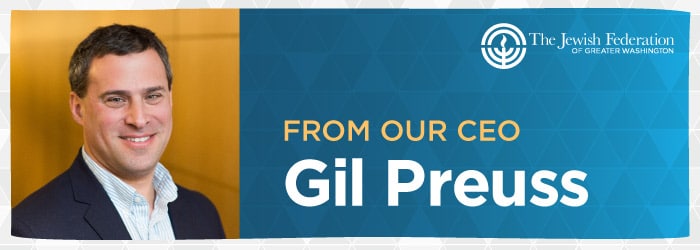-
04 January 2018

“Out of the mountain of despair, a stone of hope”
– Dr. Martin Luther King, Jr.
”To be a Jew is to help heal a broken world.”
– Rabbi Lord Jonathan Sacks
In the United States, and especially in Washington, DC, we tell our stories through statues and monuments. In part, we use these statues to honor individuals or commemorate moments in history. Those who design these fixtures of our national remembrances do so to define our past, and perhaps more importantly, to create a common narrative for the future.
I was recently inspired by a TED talk delivered by Rabbi Lord Jonathan Sacks, in which he spoke about several statues in Washington, DC and the narratives they express. The Jefferson Memorial focuses on liberty for all against tyranny, while the Lincoln Memorial focuses on the unity of the country where all are created equal. The powerful words on these memorials help define who we are as a country and the values that unite us. Similarly, much care was put into the desired narrative of the memorial for Dr. Martin Luther King, Jr. during its recent development. Sixteen quotes were included on the statue and surrounding walls – words that focus on equality and the need to continue our pursuit of justice for all.
Dr. King understood the particular experiences facing African Americans in the United States and used those to articulate a vision of equality and justice for all members of society. While the dream of which he spoke was rooted in the history and experiences of the African American community, the values and vision King espoused were universal for the future of American society.
The Jewish community today is in the midst of a debate regarding our common narrative. What defines us as a Jewish community? What is the relevance of our particular history to our present reality? What is our desired future and how do we get there? What is the value of focusing on preserving traditions versus on engaging through Tikkun Olam (repairing the world) to build a better society?
Overall, I believe that both Rabbi Sacks and Dr. King help point the way. We must be deeply particularistic. We need to engage with Judaism, by understanding our history and literature, our practices and rituals, our traditions and debates that have all served to define who we are and build our voice over 3,500 years. All of those should serve as the basis upon which we grow and sustain our community.
I believe that the Jewish community today must invest deeply in connecting to the past, educating and engaging our youth and adults and deepening our understanding of who we are. This work is not simply for its own sake. Our particular history and experiences build and sustain our universal hopes and dreams. As we engage with our traditions, we build in current and future generations that “stone of hope” towards a better tomorrow – the desire to “help heal a broken world.”
We need to fully engage in the world in which we live to build a stronger future for all. Our efforts should not only seek to strengthen the Jewish community, but expand on our own experiences to articulate and act upon our universal hopes, dreams and work to strengthen society, care for the weak and vulnerable and welcome the stranger.
Just as physical monuments are built to ensure that future generations learn about challenges and triumphs of the past, we can pass down our narratives in the way we teach and engage. In Judaism, we don’t build statues to people. We build our narrative through ongoing experiences and practices, through learning and discussion and through debate as well as action. We will build our future based on what we do today and tomorrow as individuals and as a community – a narrative that demands we connect with the past and continue to strengthen the world in which we live.
Shabbat Shalom,
Gil
